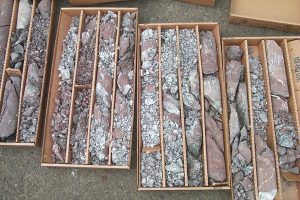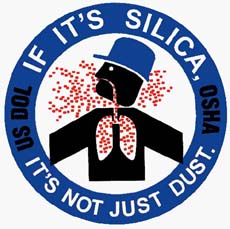Crushing, cutting, splitting, pulverizing and dividing.

Geological Samples (Source)
These are all common practices when preparing geological and mineral core samples for further testing and analysis.
Breaking down a larger sample via these methods helps reduce volume and/or particle size, creates representative samples, and preps the sample for analyses like specific gravity or bulk density.
There are several machines on the market that can crush, split and divide these samples with precision-like accuracy. Even though many of these machines enclose the crushing mechanism, renegade dust can escape during transferring and cleaning operations.
While this dust may seem benign because it is a natural material, breathing it in can pose mild to severe respiratory side effects.
Hazards of Crystalline Silica
Silica is a common threat in mineral and rock dust.
The Occupational Safety and Health Association (OSHA) has several articles devoted to the hazards of silica, here is an expert from their website:
Crystalline silica is an important industrial material found abundantly in the earth’s crust. It is a mineral that occurs in several forms. Quartz, the most common form, is a component of sand, stone, rock, concrete, brick, block, and mortar. Many of these materials are used every day across a wide variety of industrial settings, including construction, mining, manufacturing, maritime, and agriculture.
Occupational exposure to crystalline silica often occurs as part of common workplace operations involving cutting, sawing, drilling, and crushing of concrete, brick, block, rock, and stone products (such as in construction work). Operations using sand products (such as glass manufacturing, foundries, and sandblasting) can result in worker inhalation of small (respirable) crystalline silica particles from the air. These types of exposures can lead to the development of disabling and sometimes fatal lung diseases, including silicosis and lung cancer.
Dust Containment Solutions for Geological Sample Preparation
Sentry Air Systems designs and manufactures a variety of standard and custom ductless fume hoods and ducted exhaust hoods ideal for dust and particle containment.
By placing a benchtop rock sample preparation machine inside one of our hoods, operators are able to let the machine run, swap out samples and clean the machine all within a ventilated enclosure.
Our ductless fume hoods come equipped with mounted air cleaners that use high-quality HEPA filtration. The negative pressure pulls contaminated air from within the hood into the filter chamber where dust is captured and filtered.
Our exhaust hoods duct into your building’s exhaust system or can even duct outside to help protect the operator from breathing in ambient mineral dust.
While many customers use our standard off-the-shelf hoods, you may find that your particular application requires a few customizations. We offer several custom options including adjusting the access opening, using different construction materials, special cutouts on the lid and panels, adjusting the dimensions, offering multi-hinged lids and many other options.
Below are a few examples of our standard and custom hoods. You can view our entire line of standard Ductless Fume Hoods and Exhaust Hoods on our website. You can also watch a short video on our YouTube channel highlighting several of our custom hood designs.
Contact Us
If your geology lab, student lab or field research facility could benefit from dust containment please give Sentry Air Systems a call. Our sales specialists will work with you to pair the most appropriate system for your application.
Call 800.799.4609, email sales@sentryair.com, visit our website or fill out the contact form below for more information.

 Made in the USA
Made in the USA

